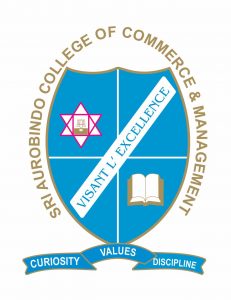NAAC
Sri Aurobindo College of Commerce and Management (SACCM) aims to contribute to the movement of nurturing the youth as leaders of tomorrow.
Home / Best Practices (2022-23)
Best Practices (2022-23)
TITLE OF BEST PRACTICE I – EXPERIENTIAL LEARNING
THE OBJECTIVE
To complement academic inputs and provide platform for students for intensive interaction with the industry, illustrious academicians and practicing managers.
THE CONTEXT
Unlike traditional classroom-based learning, which relies heavily on theoretical instruction, experiential learning is desired to actively engage students with real-world situations. It is immersive approach that bridges gap between theory and practice.
THE PRACTICE
Professionals are invited to impart their wisdom, practical experience, specialized skills, and forward-thinking ideas to students, aiming to familiarize them with the practical aspect of the concepts previously studied in class. These dialogues serve to expand students’ understanding of their subjects.
EVIDENCE OF SUCCESS
Experiential learning has enhanced student’s communication abilities and self-assurance, while also acquiring and reinforcing their decision-making skills through addressing real-world issues.Students with access to hands-on lessons are more likely to retain knowledge and more engaged with learning process.
PROBLEMS ENCOUNTERED AND RESOURCES REQUIRED
While there haven’t been any issues encountered in the planning and execution of activities, SACCM acknowledges the growing importance of extension activities in the modern world and aims to expand its initiatives.
TITLE OF BEST PRACTICE II – INFRASTRUCTURE & LEARNING RESOURCES
THE OBJECTIVE
To foster culture of academic excellence, facilitate lifelong learning, and enrich the learning experiences of both students and educators.
THE CONTEXT
Learning resources and infrastructure contribute in creating environment for effective teaching, diverse learning styles, research, technology integration, collaboration, and sustainability in education. Such thoughtful integration augments educational experience significantly.
THE PRACTICE
- Subscription to EBSCO database
- Membership of N-List programme of INFLIBNET Centre
- OPAC Kiosk
- Automation of library through EMS QualCampus
- Computer Lab having high end systems in library.
- Physical infrastructure – Computer centre, auditorium, meditation hall, badminton hall, student centre etc
- Airconditioned classrooms equipped with smartboards and internet connectivity.
- ERP Qualcampus for academic and administrative function
- Reprographic facility
EVIDENCE OF SUCCESS
Inclusion of learning materials has played pivotal role in establishing conducive setting for efficient teaching, accommodating numerous learning approaches, fostering research, integrating technology, promoting collaboration, and ensuring sustainability in education. This deliberate incorporation substantially has enhanced overall educational journey.
PROBLEMS ENCOUNTERED AND RESOURCES REQUIRED
Though no problem has been countered in planning and execution of activities yet recognizing relevance of e-governance in contemporary world, SACCM aims to scale- up e- initiatives.

